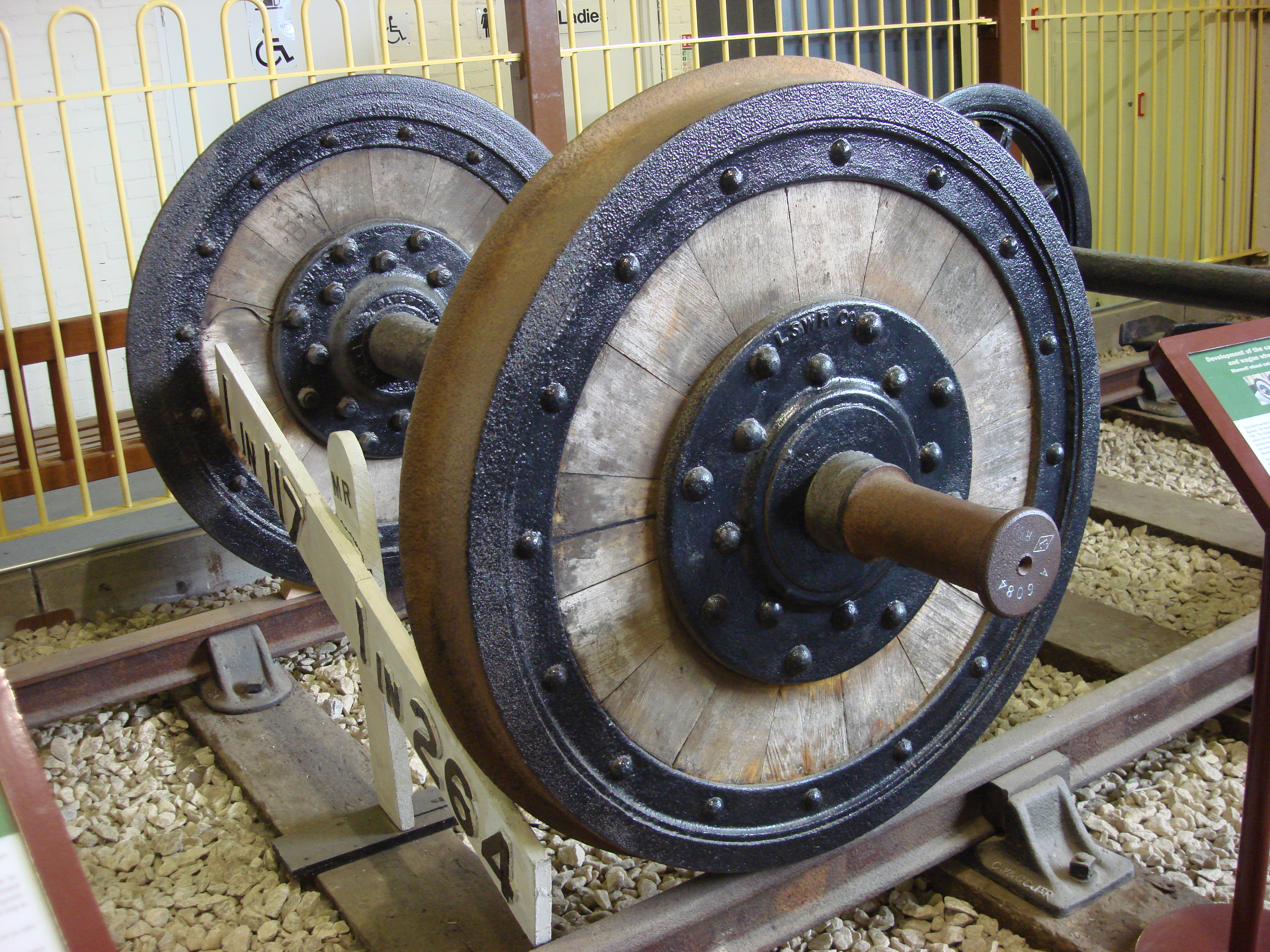Mansell wheel on:
[Wikipedia]
[Google]
[Amazon]
 The Mansell Wheel is a
The Mansell Wheel is a
 The reason for using wood was to reduce the noise. Having a wooden centre eliminated the ringing noise that emanated from early railway wheels. Made from
The reason for using wood was to reduce the noise. Having a wooden centre eliminated the ringing noise that emanated from early railway wheels. Made from  Mansell wheels were used almost exclusively on passenger coaches, but there some examples of their use on a locomotive. The
Mansell wheels were used almost exclusively on passenger coaches, but there some examples of their use on a locomotive. The
Bluebell Railway - carriage with Mansell wheels
Train wheels
 The Mansell Wheel is a
The Mansell Wheel is a railway wheel
A train wheel or rail wheel is a type of wheel specially designed for use on railway tracks. The wheel acts as a rolling component, typically press fitted onto an axle and mounted directly on a railway carriage or locomotive, or indirectly on a ...
patented by Richard Mansell, the Carriage and Wagon superintendent of the South Eastern Railway in the UK. The design was created in the 1840s and was eventually widely used on passenger railway stock in the UK. This is an interesting example of a composite wooden wheel, using the same principle as an artillery wheel
The artillery wheel was a nineteenth-century and early-twentieth-century style of wagon, gun carriage, and automobile wheel. Rather than having its spokes mortised into a wooden nave (hub), it has them fitted together in a keystone fashion with m ...
but with a solid wooden centre instead of spokes. The drawing (right) is from an old railway design book from the early 20th Century.
Overview
 The reason for using wood was to reduce the noise. Having a wooden centre eliminated the ringing noise that emanated from early railway wheels. Made from
The reason for using wood was to reduce the noise. Having a wooden centre eliminated the ringing noise that emanated from early railway wheels. Made from teak
Teak (''Tectona grandis'') is a tropical hardwood tree species in the family Lamiaceae. It is a large, deciduous tree that occurs in mixed hardwood forests. ''Tectona grandis'' has small, fragrant white flowers arranged in dense clusters (panicl ...
this type of wheel endured for a long time. Besides the reduction in noise, there was an increased safety factor. While some of this might be attributed to the extra attention paid to what were specifically passenger carriage wheels, the potential for casting
Casting is a manufacturing process in which a liquid material is usually poured into a mold, which contains a hollow cavity of the desired shape, and then allowed to solidify. The solidified part is also known as a ''casting'', which is ejected ...
faults was also reduced.
The wooden centres acted as electrical insulators so Mansell wheels would not operate the track circuit
A track circuit is an electrical device used to prove the absence of a train on rail tracks to signallers and control relevant signals. An alternative to track circuits are axle counters.
Principles and operation
The basic principle behind t ...
s used in railway signalling. This problem was solved by fitting copper bonding to the wheels.
 Mansell wheels were used almost exclusively on passenger coaches, but there some examples of their use on a locomotive. The
Mansell wheels were used almost exclusively on passenger coaches, but there some examples of their use on a locomotive. The Shropshire and Montgomeryshire Railway
The Shropshire and Montgomeryshire Light Railway was a railway running from Shrewsbury, England to Llanymynech, Wales, with a branch to Criggion. It was promoted by Holman Fred Stephens, better known as Colonel Stephens, proprietor of several u ...
's 0-4-2WT locomotive "Gazelle" has trailing wheels of the Mansell type. "Gazelle" is preserved at the Colonel Stephens Railway Museum
The Kent and East Sussex Railway (K&ESR) refers to both a historical private railway company in Kent and East Sussex in England, as well as a heritage railway currently running on part of the route of the historical company.
Historical company ...
.
The first examples built of the GWR 4-4-0 Duke class of 1895 also used Mansell wheels for their bogie and tender. Another tank locomotive 0-4-4T class bogie used Mansel (sic) wheels.
Re-use of wooden segments
The wooden segments of the wheel had a shorter life than other parts, and were replaced at intervals, usually because they had become loose in the wheel rim, not because the timber was otherwise damaged. This valuable teak was often re-used. As the segments were too short for most woodworking uses, they were typically re-used as wooden flooring blocks. These were particularly common for outdoor use in railway stations, around milk loading docks and platforms that handled postal traffic. These platforms were regularly in use overnight and the wooden blocks provided a quieter surface thancobblestones
Cobblestone is a natural building material based on cobble-sized stones, and is used for pavement roads, streets, and buildings.
Setts, also called Belgian blocks, are often casually referred to as "cobbles", although a sett is distinct f ...
for the station's neighbours, even with iron-tyred carts running over them. An example of such a wood block pavement made from wheel segments survives at Liverpool's Edge Hill.
See also
*Paper car wheel
Paper car wheels were composite wheels of railway carriages, made from a wrought iron or steel rim bolted to an iron hub with an interlayer of laminated paper.John H. Lienhard''Engines of Our Enginuity, No. 758: Paper railroad wheels.''/ref> Th ...
, a US design using a compressed paper inner
References
* *External links
{{Commons category, Mansell wheelsBluebell Railway - carriage with Mansell wheels
Train wheels